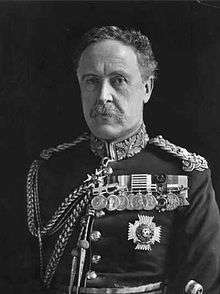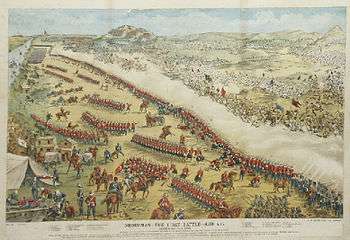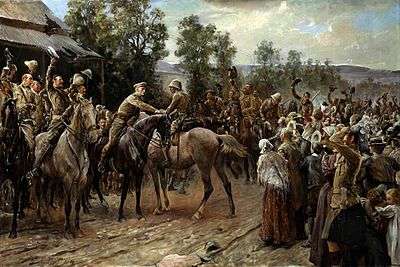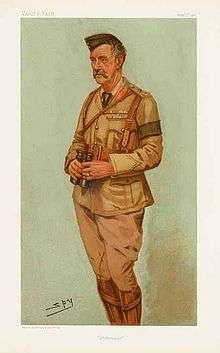Neville Lyttelton
| Sir Neville Lyttelton | |
|---|---|
 General Sir Neville Lyttelton | |
| Born |
28 October 1845 Hagley, Worcestershire |
| Died |
6 July 1931 (aged 85) Royal Hospital Chelsea, London |
| Allegiance | United Kingdom |
| Service/branch | British Army |
| Years of service | 1865–1912 |
| Rank | General |
| Commands held |
Commander-in-Chief, Ireland Chief of the General Staff Commander-in-Chief, South Africa 4th Division 2nd Division 4th Brigade 2nd Brigade 2nd Battalion Rifle Brigade 1st Battalion Rifle Brigade |
| Battles/wars |
Fenian Raids Anglo-Egyptian War Mahdist War Second Boer War |
| Awards |
Knight Grand Cross of the Order of the Bath Knight Grand Cross of the Royal Victorian Order Mentioned in Despatches Order of Osmanieh (Ottoman Empire) |
| Relations | Charles Masterman (son-in-law) |
General Sir Neville Gerald Lyttelton, GCB, GCVO, PC (28 October 1845 – 6 July 1931) was a British Army officer from the Lyttelton family who served against the Fenian Raids, and in the Anglo-Egyptian War, the Mahdist War and the Second Boer War. He was Chief of the General Staff at the time of the Haldane Reforms and then became Commander-in-Chief, Ireland.
Army career
Born the son of 4th Baron Lyttelton and Mary Lyttelton (née Glynne) and educated at Eton College, Lyttelton was commissioned into the Rifle Brigade in January 1865.[1] As a junior officer he was sent to Canada where he helped defeat the Fenian raids in 1866 and served as Secretary to the Oregon Boundary Commission in 1867.[1] He was promoted to lieutenant on 14 July 1869,[2] to captain on 13 October 1877[3] and to major on 22 February 1882.[4] In 1880 he was made Private secretary to Hugh Childers, Secretary of State for War.[1]
He took part in the Anglo-Egyptian War in 1882 as an Aide-de-Camp to Sir John Adye, from 1 August 1882.[5] He saw action at the Battle of Tel el-Kebir and was mentioned in despatches.[6] He was promoted to brevet lieutenant colonel[7] and awarded the Order of Osmanieh (4th Class) on 17 November 1882.[8]
He became Assistant Military Secretary to Lieutenant General Sir John Adye in his role as Governor of Gibraltar on 1 January 1883[9] and Military Secretary to Lord Reay, Governor of Bombay in 1885.[1] In his young life he made friends, mixing in whiggish aristocratic circles with Edward Grey and Arthur Balfour, later the shapers of imperial foreign policy.[10] He was promoted to brevet colonel on 18 November 1886[11] and became second-in-command of the 3rd Battalion of his Regiment in 1890.[1] Promoted to the substantive rank of lieutenant colonel on 9 November 1892,[12] he became Commanding Officer of the 1st Battalion of his Regiment in 1893 and went on to be Commanding Officer of the 2nd Battalion of his Regiment in Ireland.[1]

He went on to be Assistant Adjutant-General at Headquarters in December 1894 and Assistant Military Secretary there in October 1897[1] and took part in the state funeral of Former Prime Minister William Gladstone in May 1898.[13]
He was given command of 2nd Brigade with the temporary rank of brigadier general on 13 July 1898[14] and led his brigade at the battle of Omdurman in September 1898 during the Mahdist War.[1]
He returned to his role as Assistant Military Secretary at Headquarters on 21 October 1898[15] and then, having become a supernumerary major general for distinguished service in the field on 15 November 1898[16] and promoted to the substantive rank of major general on 10 February 1899,[17] he briefly took back his old command at 2nd Brigade, now based at Aldershot Command, on 1 September 1899.[18]
Lyttelton served in the Second Boer War as Commander of the 4th Brigade in South Africa from 9 October 1899.[19] He temporarily became General Officer Commanding the 2nd Division in February 1900,[20][21] then commanded the 4th Division,[22] and was involved in the Battle of Spion Kop in January 1900 and the Battle of Vaal Krantz in February 1900, leading to the Relief of Ladysmith later that month.[1] Promoted to lieutenant general for distinguished service in the field on 22 March 1900,[23] Lord Roberts in his despatch referred to Lyttelton as an officer "with great coolness under fire, and considerable tactical knowledge and resource...an excellent commander in the field."[24] He was in command of the troops in Natal until June 1902, when he became Commander-in-Chief of the whole of South Africa following the end of the Second Boer War the previous month.[25] In this role Lyttelton and his wife sought to repair relations with the Boer community.[1] In the South Africa honours list published on 26 June 1902, Lyttelton was knighted as a Knight Commander of the Order of the Bath (KCB).[26]

On 12 February 1904 he was appointed Chief of the General Staff and a member of the newly formed Army Council.[27] This new post was created following the abolition of the post of Commander-in-Chief of the Forces as recommended by Lord Esher in the Esher Report.[1] Lyttelton was promoted to general on 9 April 1906.[28] This was the time of the Haldane Reforms which sought to implement both a new expeditionary force and a new territorial force, but according to Edward M Spiers, Lyttelton was not up to the task – he was "feckless, malleable, and failed to lead the Army Council".[1]
Lyttelton moved on to become Commander-in-Chief, Ireland on 10 May 1908.[29] He took part both in the funeral procession following the death of King Edward VII in May 1910[30] and the coronation procession for King George V in June 1911.[31] He was appointed Knight Grand Cross of the Royal Victorian Order on 12 July 1911[32] and retired on 10 August 1912.[33]
In retirement he was a member of the Mesopotamia Commission which sat in 1916/17.[34]
The King insisted he was appointed as Governor of the Royal Hospital Chelsea from 10 August 1912[35] until his death there on 6 July 1931.[1]

Family
In 1883 he married Katharine Sarah Stuart-Wortley; they had three daughters, the eldest being Lucy Blanche.[36]
References
- 1 2 3 4 5 6 7 8 9 10 11 12 13 "Neville Lyttelton". Oxford Dictionary of National Biography. Retrieved 18 February 2012.
- ↑ The London Gazette: no. 23516. p. 3957. 13 July 1869. Retrieved 2012-02-18.
- ↑ The London Gazette: no. 24517. p. 5923. 30 October 1877. Retrieved 2012-02-18.
- ↑ The London Gazette: no. 25085. p. 1214. 17 March 1882. Retrieved 2012-02-18.
- ↑ The London Gazette: no. 25134. p. 3580. 1 August 1882. Retrieved 2012-02-18.
- ↑ The London Gazette: no. 25162. p. 4879. 2 November 1882. Retrieved 2012-02-18.
- ↑ The London Gazette: no. 25169. p. 5174. 17 November 1882. Retrieved 2012-02-18.
- ↑ The London Gazette: no. 25169. p. 5168. 17 November 1882. Retrieved 2012-02-18.
- ↑ The London Gazette: no. 25175. p. 6250. 8 December 1882. Retrieved 2012-02-18.
- ↑ D.Owen, "The Military Perspective", p.35
- ↑ The London Gazette: no. 25645. p. 5530. 16 November 1886. Retrieved 2012-02-18.
- ↑ The London Gazette: no. 26343. p. 6238. 8 November 1892. Retrieved 2012-02-18.
- ↑ The London Gazette: no. 26980. p. 3845. 22 June 1898. Retrieved 2012-02-18.
- ↑ The London Gazette: no. 26988. p. 4355. 19 July 1898. Retrieved 2012-02-18.
- ↑ The London Gazette: no. 27015. p. 6056. 18 October 1898. Retrieved 2012-02-18.
- ↑ The London Gazette: no. 27023. p. 6689. 15 November 1898. Retrieved 2012-02-18.
- ↑ The London Gazette: no. 27064. p. 1906. 21 March 1899. Retrieved 2012-02-18.
- ↑ The London Gazette: no. 27113. p. 5443. 1 September 1899. Retrieved 2012-02-18.
- ↑ The London Gazette: no. 27126. p. 6180. 13 October 1899. Retrieved 2012-02-18.
- ↑ "The War - Natal". The Times (36067). London. 16 February 1900. p. 5.
- ↑ The London Gazette: no. 27282. p. 937. 8 February 1901. Retrieved 2012-02-18.
- ↑ The London Gazette: no. 27282. p. 962. 8 February 1901. Retrieved 2012-02-18.
- ↑ The London Gazette: no. 27306. p. 2703. 19 April 1901. Retrieved 2012-02-18.
- ↑ The London Gazette: no. 27282. p. 976. 8 February 1901. Retrieved 2012-02-18.
- ↑ "Latest intelligence – The South African command". The Times (36792). London. 12 June 1902. p. 7.
- ↑ The London Gazette: (Supplement) no. 27448. p. 4191. 26 June 1902.
- ↑ The London Gazette: no. 27645. p. 939. 12 February 1904. Retrieved 2012-02-18.
- ↑ The London Gazette: no. 27907. p. 2798. 24 April 1906. Retrieved 2012-02-18.
- ↑ The London Gazette: no. 28137. p. 3578. 15 May 1908. Retrieved 2012-02-18.
- ↑ The London Gazette: (Supplement) no. 28401. p. 5481. 26 July 1910. Retrieved 2012-02-18.
- ↑ The London Gazette: (Supplement) no. 28535. p. 7095. 26 September 1911. Retrieved 2012-02-18.
- ↑ The London Gazette: no. 28513. p. 5265. 14 July 1911. Retrieved 2012-02-18.
- ↑ The London Gazette: no. 28634. p. 5921. 9 August 1912. Retrieved 2012-02-18.
- ↑ "'Appendix 1', Office-Holders in Modern Britain: Volume 10: Officials of Royal Commissions of Inquiry 1870–1939 (1995), pp. 85–8". British History Online. Retrieved 12 February 2012.
- ↑ The London Gazette: no. 28634. p. 5919. 9 August 1912. Retrieved 2012-02-18.
- ↑ "Neville Lyttelton". The Peerage.com. Retrieved 18 February 2012.
Bibliography
- Spiers, Edward M. (1984). Haldane: Army Reformer. Edinburgh University Press. ISBN 978-0-85224-370-1.
External links
| Military offices | ||
|---|---|---|
| Preceded by Lord Roberts (as Commander-in-Chief of the Forces) |
Chief of the General Staff 1904–1908 |
Succeeded by William Nicholson |
| Preceded by Lord Grenfell |
Commander-in-Chief, Ireland 1908–1912 |
Succeeded by Sir Arthur Paget |
| Preceded by Sir John Glyn |
Colonel-Commandant of the 4th Battalion, Rifle Brigade (Prince Consort's Own) 1912–1921 |
Succeeded by Sir Victor Couper |
| Honorary titles | ||
| Preceded by Sir George White |
Governor, Royal Hospital Chelsea 1912–1931 |
Succeeded by Sir Walter Braithwaite |
